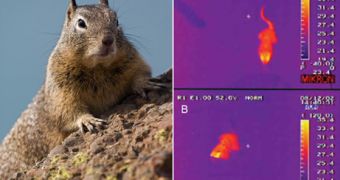Like any reptile, a snake loves the heat. But not in the case of the rattlesnake, when confronted by California ground squirrels.
A team at the University of California, Davis found that these rodents warm up their Tails to ward off rattlesnakes. And when facing a squirrel waving a "hot" tail over its head, northern Pacific rattlesnakes will cede and retreat.
The squirrel's tail, heated or not, does not represent a menace by itself to the rattlesnake. Its role is to signal to the snake that the adult squirrels are prepared for defending their offspring from a rattlesnake attack.
The thermal signaling works because rattlesnakes have between their nostrils and upper lips two specialized heat sensitive organs that detect infrared radiation (heat) emanated by small mammals, their main prey.
The heat "increases the conspicuousness of the squirrel's tail-flagging display. This display signals to the snake that it has been detected, and that it is likely to be harassed by the squirrel and other[s] in the vicinity." said lead author Aaron Rundus. "The squirrel likely warms its tail by increasing blood flow from its body to the normally cooler tail region," added co-author Donald Owings.
Rattlesnakes feed on ground squirrels largely through surprise attacks on the young ones, but they avoid potentially deadly confrontations with adults, which are immune to their venom, "and therefore are well set up to confront rattlesnakes in very prolonged and intense encounters," said Rundus.
That's why when it becomes impossible to take its prey by surprise, the rattlesnake usually backs off.
The team employing infrared imaging technique compared in the lab the squirrels' response to both northern Pacific rattlesnakes and gopher snakes. Apparently, there was no difference in the squirrels' tail-waving response in the case of both snake species.
But the infrared images showed squirrels increased their tail temperature up to 9? F (5? C) when menaced by rattlesnakes, but not when confronting gopher snakes, which do not have heat sensitive pits.
"The selective use of infrared tail flagging reveals an exacting discriminatory ability on the part of the squirrels," said James Hare of the University of Manitoba in Winnipeg, not involved in the research.
In another approach, the team presented to rattlesnakes lifelike squirrel robots waving heated or unheated tails. A rise in tail temperature stopped the snakes from approaching.
The new study shows that the signals sent by an animal must march the sensory abilities of its signal receiver.
"This study reinforces the importance of receiver sensory biases in signal evolution. Even more importantly, it emphasizes the critical importance of resolving signals outside human perceptual limits in understanding the behavior of animals." said Hare. The squirrel's tail, when heated, acts in fact exactly like the rattling of the rattlesnakes. To avoid spending energy when it comes to defence, both species have developed highly noticeable warning signals for their enemies.
"The squirrels themselves have no way of detecting their own heat signal. And there's a good chance that rattlesnakes cannot hear themselves rattle," said Owings.

 14 DAY TRIAL //
14 DAY TRIAL //